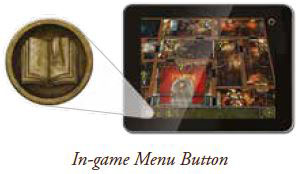
This section includes additional rules not previously discussed, including skill tests, cards, features, monsters, and puzzles.
Damage & Horror
Many game effects cause investigators to suffer Damage or Horror. When an effect causes an investigator to suffer Damage or Horror, he draws the top card of the Damage or Horror deck, respectively. He claims the card faceup unless the effect specifies otherwise.
Each Damage or Horror card has one of two traits-Resolve Immediately or Keep Faceup. When an investigator claims a faceup Damage or Horror with the Resolve Immediately trait, he immediately resolves its effect which usually includes flipping the card facedown. A Damage or Horror with the Keep Faceup trait, will have a lasting effect for as long as the card remains faceup.

Wounded
When an investigator has suffered Damage (whether faceup or facedown) equal to his health, that investigator becomes Wounded.
When an investigator becomes Wounded, he gains a Wounded Condition and discards all of his facedown Damage. While Wounded, an investigator cannot perform the move action more than once each round.
When a Wounded investigator has suffered Damage equal to his health, that investigator is eliminated.
Insane
When an investigator has suffered Horror (whether faceup or facedown) equal to his sanity, that investigator becomes Insane.
When an investigator becomes Insane, he gains an Insane Condition and discards all of his facedown Horror cards. He reads the back of his Insane Condition, but he cannot reveal the back of the card to the other investigators.
An investigator's Insane Condition might alter how that investigator wins and loses the game. In such a case, he may want to perform one or more actions that he would not otherwise want to perform. See "Rarely Used Actions" on the last page of the Rules Reference.
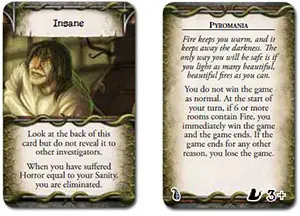
Each Insane Condition has a required number of investigators which is indicated on the bottom-right corner on the back of the card. When an investigator gains an Insane Condition, if the number of investigators is less than the required number of investigators, he discards that card and gains a different copy of the Insane Condition.
If an Insane investigator has suffered Horror equal to his sanity, that investigator is eliminated.
Eliminated
When an investigator is eliminated, he drops all of his possessions in his space and removes his investigator figure from the board. The remaining investigators have a single additional investigator phase to attempt to complete their investigation.
At the end of that investigator phase, if the investigators did not complete the investigation, they lose the game. One of them selects the "Investigator Eliminated" option from the in-game menu to end the game.
Skill Tests
A skill test represents a physical, mental, or social challenge an investigator must overcome. Skill tests are declared using their skill icon embedded in parentheses following a short narrative. When an investigator is resolving an effect that includes a skill icon in the text, he must immediately test that skill.
To resolve a test, the investigator rolls a number of dice equal to his value in the indicated skill. The number of success results ( ) rolled is called the test result. The test declaration might also indicate a modifier, such as "-1", which causes the investigator to roll more or fewer dice for the skill test. Investigators roll a minimum of one die for each test.
) rolled is called the test result. The test declaration might also indicate a modifier, such as "-1", which causes the investigator to roll more or fewer dice for the skill test. Investigators roll a minimum of one die for each test.
After rolling dice during a test, an investigator may spend a Clue to convert a single investigation result ( ) to a success result (
) to a success result ( ). He may do so multiple times as long as he spends a Clue for each
). He may do so multiple times as long as he spends a Clue for each  he converts. He determines his test result after resolving all conversions.
he converts. He determines his test result after resolving all conversions.
Negating Damage & Horror
Some effects cause an investigator to suffer multiple Damage or Horror at the same time but allow him to resolve a skill test to negate some or all of the Damage or Horror. To do so, the investigator tests the indicated skill. He prevents one Damage or one Horror for each success result ( ) rolled.
) rolled.
Skill Test Difficulty
Some skill test declarations include a test difficulty embedded in the parentheses separated from the skill icon by a semicolon. This number indicates the number of success results ( ) required to pass the test. If the investigator does not roll enough
) required to pass the test. If the investigator does not roll enough  he fails the test.
he fails the test.
Skill Tests In The App
Some skill test declarations included in app instructions require the investigator to input his test result. In such a case, the investigator uses the "+" and "-" buttons to input his test result.

The number of success results ( ) required to pass is unknown. However, even if the investigator fails the test, the app remembers how many
) required to pass is unknown. However, even if the investigator fails the test, the app remembers how many  were previously rolled. Future attempts to pass the test will require fewer
were previously rolled. Future attempts to pass the test will require fewer  .
.
Message Log
During the game, all messages displayed by the app are recorded in the message log. Players may access the message log at any time by selecting "Message Log" from the in-game menu.
The message log is organized by round and allows the players to reread any messages shown by the app throughout the course of the game.
Monsters
Monsters represent aberrant and eldritch creatures and the cultists and other worshipers of those creatures.
Monster Token
Each monster token includes a number of pieces of game information as described below.
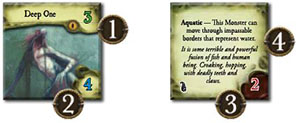
1 Awareness: A monster's awareness is referenced when an investigator resolves an evade check in a space that contains multiple monsters.
2 Horror Rating: A monster's horror rating is referenced when an investigator resolves a horror check within range of multiple monsters.
3 Brawn: A monster's brawn represents its physical prowess and is referenced by various effects. See "Barricades" on page 16.
4 Abilities & Flavor Text: A monster's abilities, if it has any, are defined on the token's back. A monster's flavor text gives a brief thematic description of the creature's appearance and behavior.
ID Tokens
ID tokens are used to mark unique monsters and to differentiate monsters from others of the same type.
When a monster is spawned, the app might indicate one of the six ID tokens to be assigned to that monster. An investigator places the specified ID token in the monster figure's base.
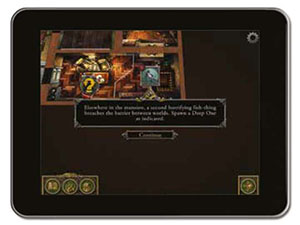
A monster retains its ID token for as long as it remains in play.
Evading Monsters
If an investigator in a space containing a monster attempts to leave his space or perform an action other than the attack action or move action, that investigator must first evade the monster. If there are multiple monsters in the investigator's space, he must evade only the monster with the highest awareness.
To evade a monster, an investigator selects the monster in his space from the monster drawer. Then the investigator presses the "Evade" button and resolves the effect as instructed by the app.
After evading a monster, the investigator performs his action as normal unless the effect states that his action is forfeit.
If the investigator forfeits his action, he loses his action without resolving any part of its effect. If an investigator forfeits his action while moving, he loses any remaining movement and does not leave his space.
Items
Common Items and Unique Items represent the various objects the investigators encounter during their investigations. When an investigator gains an item, he claims the card faceup (art side faceup).
Some Items have a unique back. An investigator may read the back of an item at any time.
Spells
Spells represent the tomes or scrolls containing the knowledge required to harness eldritch powers. When an investigator gains a Spell, he claims a random copy of that Spell faceup (art side faceup). An investigator cannot look at the back of a Spell until an effect causes the Spell to flip.
Whenever an investigator casts a Spell, the Spell's effect instructs the investigator to flip the card. When he flips the card, he immediately resolves the effect on its back. This effect typically includes discarding the card and gaining a new copy of that Spell.
Conditions
Conditions represent intangible status effects that alter how an investigator can act. Occasionally, an effect will cause an investigator to gain a Condition. For example, "become Stunned" causes the investigator to gain the Stunned Condition.
Features
Features represent noteworthy furnishings or environmental effects that investigators can interact with or that affect how an investigator can interact with his surroundings. All features are square tokens. Interacting with a feature does not require the app.
Barricades
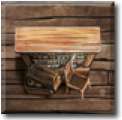
A Barricade allows an investigator to block a door to prevent monsters from getting through. As an action, an investigator in a space containing a Barricade may move the Barricade against a door or move the Barricade away from the door it blocks.
Investigators and monsters cannot move through blocked doors. However, a monster can destroy a Barricade that blocks its path. If a monster attempts to move through a blocked door, it rolls a number of dice equal to its brawn. If it rolls two or more success results ( ), the Barricade is discarded and the monster moves as normal. Otherwise, the monster does not move.
), the Barricade is discarded and the monster moves as normal. Otherwise, the monster does not move.
Darkness
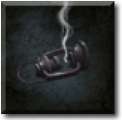
Darkness hinders an investigator's ability to resolve skill tests and puzzles. An investigator in a space containing Darkness cannot spend Clues to convert dice results or perform additional puzzle steps.
Each investigator in or adjacent to a space containing a Light Source or Fire ignores the effects of Darkness.
Fire
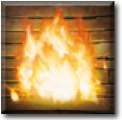
Fire spreads and can damage investigators and monsters. Whenever an investigator moves into a space containing Fire or performs an action in a space containing Fire, he suffers one facedown Damage.
Whenever a monster starts its activation in a space containing Fire or moves into a space containing Fire, it suffers one damage.
As an action, an investigator may attempt to extinguish the flames by testing his agility. For each success result ( ) he rolls, he may discard one Fire token from his space or a space he moves into if he moves as part of his second action or later in the round.
) he rolls, he may discard one Fire token from his space or a space he moves into if he moves as part of his second action or later in the round.
At the beginning of each mythos phase, fire spreads. If one or more spaces contain Fire, place one Fire token in a space adjacent to a space that contains Fire.
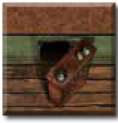
Secret Passages
An investigator or monster in a space containing a Secret Passage can move to any other space containing a Secret Passage as if those spaces were adjacent.
Puzzles
Occasionally, an investigator will encounter an effect that requires him to solve a puzzle. Puzzles represent complex logical, magical, or physical challenges the investigators must overcome to complete their investigation. Puzzles are resolved in their entirety using the app.
Puzzle Steps
A puzzle step is a single unit of progress toward solving a puzzle, and the types of puzzle steps the investigator can perform are defined by the type of puzzle he is resolving as indicated by the app.
Whenever an effect instructs an investigator to attempt a puzzle, that investigator performs a number of puzzle steps equal to his value in the skill indicated by that effect.
While attempting a puzzle, an investigator may spend any number of his Clues to perform one additional puzzle step for each Clue spent.
After an investigator has performed all of his allotted puzzle steps, if the puzzle is not solved, he presses the "Close" button. The investigator's progress will be saved so that he or another investigator can continue solving the puzzle at a later time.
Solving A Puzzle
The app will automatically detect when a puzzle is solved. At which point, the investigator who solved the puzzle will continue resolving his action as instructed by the app.
Slide Puzzle
A slide puzzle is a type of puzzle in which an investigator attempts to assemble an image that has been split into six or more pieces. The pieces of a slide puzzle are displayed in a grid and randomized.
As a puzzle step, an investigator can swap any two adjacent pieces by dragging one of them over the other.
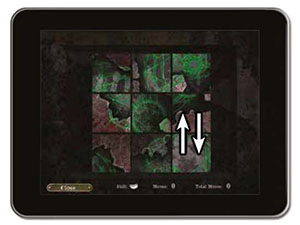
The puzzle is solved when all pieces of the puzzle are in the correct position and the puzzle's image is properly displayed.
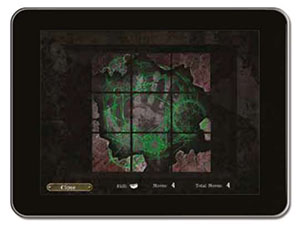
Code Puzzle
A code puzzle is a type of puzzle in which an investigator attempts to determine a code made of three or more pieces-numbers or runes. The unique pieces that can make up the code are displayed at the top of the screen, and each piece can be used any number of times.
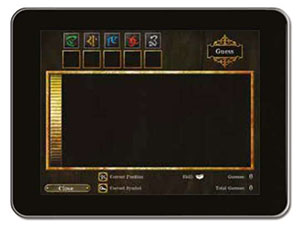
As a puzzle step, an investigator can guess the code. He does so by dragging one piece into each of the current guess brackets (1) and selecting "Guess" (2).
After submitting a guess, the investigator will receive information about his guess (3). The app will mark each incorrect guess with a number of success results ( ) and investigation results (
) and investigation results ( ).
).
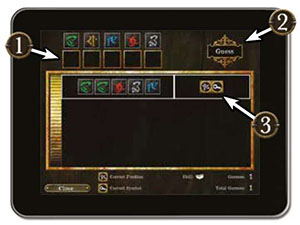
Each indicates that a single piece of the guess is the correct piece and is correctly positioned within the code. Each  indicates that the guess contains a single correct piece, but that piece is not in the correct position.
indicates that the guess contains a single correct piece, but that piece is not in the correct position.
The puzzle is solved when the investigator guesses the correct code.
Lock Puzzle
A lock puzzle is a type of puzzle in which an investigator attempts to maneuver pieces in a grid to allow the visually unique goal piece to be removed from the grid.
As a puzzle step, an investigator can move any piece by dragging it. A piece can be moved only in the direction of its orientation-vertically or horizontally. However, no two pieces can occupy the same space of the grid, and a piece cannot be moved through other pieces.
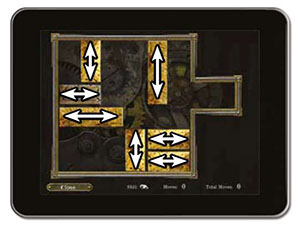
The puzzle is solved when the goal piece is moved to the far right side of the grid.
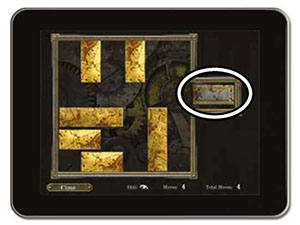
Continue Reading
